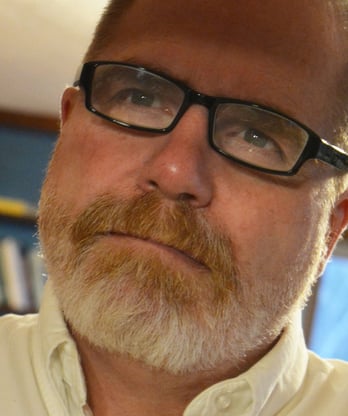

I'm a digger for facts, and I'm in search of other diggers — medical researchers who go down deep into their disease area and notice things that others in their field overlook.
There are the facts that are widely known and accepted, and then there are facts under the apparent surface reality that often determines outcomes. It is those facts — the facts under the surface — that are crucial to achieving our ultimate objective: recovery.
I have the tenacity of a bloodhound on a scent when it comes to those deeper facts — the search for who really understands a particular disease, and has clear evidence of a possible solution.
- Roderick MacIver
My Background
I grew up in Canada. At the age of eighteen, I became a real estate agent in Ottawa. Within a couple of years I was selling hotels and nursing homes. I began buying and renovating properties, first in Ottawa, then in Calgary Alberta. I became a stockbroker, then investment manager in Toronto. I opened an institutional investment research firm in New York City, and conducted pre-offer due diligence for corporate acquirers, mostly private equity firms, for six years. I also sold investigative research -- "Contrarian Research" -- to about a hundred institutions -- Fidelity, T Rowe Price, etc. Then, thirty years ago, I became an artist and book author, and founded the Heron Dance Art Studio. Over the last thirty years, I’ve authored fourteen books that combined my art, writing and inspiring quotes from others.
Pre-Offer Due Diligence for Corporate Acquirers
In the late 1980s and early 1990s, I looked for hidden problems for acquirers of companies. I looked for where the bodies were buried and the skeletons hidden in potential acquisition candidates. I researched asset values, emerging competitor technologies and customer opinions. I’d sit in a bar outside a factory when the shifts changed and buy a worker a beer or two. It is often surprising what they know about the CEO, who he’s having an affair with and how much golf he plays. I’d photograph parking lots outside of corporate head offices at 5pm on a Friday afternoon and get a rough idea of company morale. I’d photograph CEO’s homes and draw their credit reports — you can often tell a lot about a person by where they live and by their credit history. I would sometimes hire former senior executives and directors as “industry consultants.” I found that if you approach a hundred people for information, you might get crucial insights from one or two and important collaboration on key facts from four or five more. (Article written about me from those days in Barron’s, a major financial journal.)
In summary, if you had a company to sell and it had a deep, dark, hidden secret, you wouldn't want to see me show up on your doorstep. With this medical research the challenge is different. No one is trying to keep things secret, unless of course a therapy hasn't yet been patented. But mostly what we looking for is hidden because those working on it are too busy doing the work to publicize it. I've encountered physicians running trials of promising drugs that have only one or two enrollees. They are not actively recruiting because they are running a practice, running three or four small-scale trials, and are not motivated to publicize what they are finding.
My History With Cancer
I’ve been diagnosed with cancer twice. Stage 4a non-Hodgkin’s Lymphoma and prostate cancer, Gleason score of 7 (3+4). The lymphoma, at the time, before the advent of Rituxan, was considered incurable. Stage 4a means the disease had migrated to my bone marrow. I had 52 tumors throughout my body including one in my mesentery that measured 15 x 22 cm. I was told by my oncologist that of the thousands of people diagnosed every year with the form of lymphoma I had, there was only one documented case of long term survival that he was aware of. And seven years or so ago I was diagnosed with prostate cancer.
When addressing my two cancer diagnoses, I used the same research and interview techniques developed in acquisition due diligence. I found out who was doing groundbreaking research and asked them for an interview. Few responded but those who did provided valuable information. Sometimes they would point me towards others they particularly respected and who were engaged in innovative research. These interviews led me to enroll in three trials — one at the NIH in Bethesda, Maryland, and another at the Dana Farber, both for lymphoma, neither of which helped, and one at the Brigham and Women's in Boston (for prostate cancer) that did.
Ultimately, in the case of lymphoma, I found a drug in Germany developed by the chemist who headed the Red Cross there. It was originally developed to treat physicians who returned from Chernobyl with sublethal radiation exposure. Leukemia is a common side affect of sublethal radiation. That drug — WF10 — not only prevented any of them from getting lymphoma, but had a dramatic, positive impact on my own health. It allowed me to survive until Rituxan became available. Before that, I had been enrolled in an experimental autologous bone marrow transplant program at the Dana Farber. I was removed from that program when my blood counts deteriorated as a result of chemo. I was anemic, a borderline hemophiliac and was told that as a result, I couldn’t get any more chemo. I was out of options. The combination of Rituxan and WF10 saved my life, I now believe.
In the case of prostate cancer, I enrolled in a trial at the Women and Brigham’s hospital in Boston. Once a month, they injected a genetically modified virus developed in Japan into my prostate that created antibodies that fought the cancer. After three of these injections, an MRI indicated I was cancer free. A biopsy several months later showed, however, that it had returned. I do believe though that that virus therapy prevented the disease from spreading to nearby tissue, as is common in patients with my Gleason score. Because it had not migrated, I was able to get radio implants. That was several years ago. So far, no sign of recurrence.


Let me know if you'd like to talk.
(802)234-3120 (Office)
(843)802-0183 (Mobile)
(rod@emergingcures.org)
17 Executive Park Road, Office 4B
Hilton Head Island, SC 29928
(Small office complex between the
fire station and Stellini's Restaurant)
